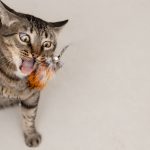Introduction: Cats, adorned with their exquisite whiskers, possess sensory tools that transcend their superficial elegance. These facial features play a pivotal role in a cat’s daily life, influencing their interactions with the world around them. This exploration unravels the multifaceted functions of cat whiskers, shedding light on their significance and the intricacies of whisker care.
Section 1: The Remarkable Roles of Cat Whiskers
- Sense of Touch:
- Detailing how cat whiskers function as a tactile sense organ.
- Highlighting the sensory cells within whisker follicles that transmit information similar to human fingertips.
- Sense of Orientation:
- Explaining the proprioceptive ability of certain whisker follicles.
- The role of whiskers in helping cats maintain awareness of their orientation in relation to gravity.
- Communication:
- Investigating the communication aspect of cat whiskers.
- Discussion on how tiny muscles around the whisker base enable cats to convey their emotions and intentions.
Section 2: Whisker Anatomy and Quantity
- Whisker Distribution:
- Describing the ordered arrangement of whiskers, with specific counts on the upper lip, above the eyes, on the chin, and at the back of the wrists.
- Highlighting the regular spacing and growth patterns of whiskers.
- Potential Whisker Fatigue:
- Introducing the concept of whisker fatigue.
- Identifying causes, such as chronic pressure on whiskers, and its association with inappropriate dish sizes.
- Impact of Diseases and Medications:
- Discussing how diseases affecting the haircoat can impact whiskers.
- Mentioning medications, like chemotherapy drugs, that may lead to whisker loss.
Section 3: Whisker Care and Controversies
- Cutting Cat Whiskers:
- Addressing the question of cutting cat whiskers.
- Emphasizing that while cutting is not painful, it can be stressful and confusing for cats due to the sudden change in sensory input.
- Whisker Regrowth:
- Assuring pet owners that whiskers can regrow if broken or trimmed for medical reasons.
- Explaining the normal shedding of whiskers and the time it takes for regrowth.
- Color Changes in Whiskers:
- Acknowledging the normal phenomenon of whisker color changes.
- Explaining that color changes do not affect the functionality of the whiskers.
Conclusion: Nurturing the Whisker Connection Cat whiskers, far from being mere adornments, are indispensable tools that contribute to a feline’s well-being. Understanding the various functions of whiskers allows pet owners to appreciate the sensory world their cats navigate. Respecting whisker care and avoiding unnecessary interference ensures that cats can confidently explore their surroundings, maintaining a harmonious connection between cats and their whiskers. Always consult with a veterinarian for any concerns regarding the health of these fascinating sensory structures.


